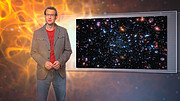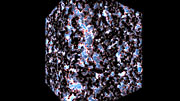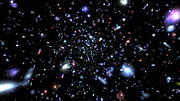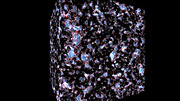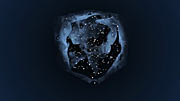Press Release
Clearing the Cosmic Fog
The Most Distant Galaxy Ever Measured
20 October 2010

A European team of astronomers using ESO’s Very Large Telescope (VLT) has measured the distance to the most remote galaxy so far. By carefully analysing the very faint glow of the galaxy they have found that they are seeing it when the Universe was only about 600 million years old (a redshift of 8.6). These are the first confirmed observations of a galaxy whose light is clearing the opaque hydrogen fog that filled the cosmos at this early time. The results were presented at an online press conference with the scientists on 19 October 2010, and will appear in the 21 October issue of the journal Nature.
“Using the ESO Very Large Telescope we have confirmed that a galaxy spotted earlier using Hubble is the most remote object identified so far in the Universe” [1], says Matt Lehnert (Observatoire de Paris) who is lead author of the paper reporting the results. “The power of the VLT and its SINFONI spectrograph allows us to actually measure the distance to this very faint galaxy and we find that we are seeing it when the Universe was less than 600 million years old.”
Studying these first galaxies is extremely difficult. By the time that their initially brilliant light gets to Earth they appear very faint and small. Furthermore, this dim light falls mostly in the infrared part of the spectrum because its wavelength has been stretched by the expansion of the Universe — an effect known as redshift. To make matters worse, at this early time, less than a billion years after the Big Bang, the Universe was not fully transparent and much of it was filled with a hydrogen fog that absorbed the fierce ultraviolet light from young galaxies. The period when the fog was still being cleared by this ultraviolet light is known as the era of reionisation [2]. Despite these challenges the new Wide Field Camera 3 on the NASA/ESA Hubble Space Telescope discovered several robust candidate objects in 2009 [3] that were thought to be galaxies shining in the era of reionisation. Confirming the distances to such faint and remote objects is an enormous challenge and can only reliably be done using spectroscopy from very large ground-based telescopes [4], by measuring the redshift of the galaxy’s light.
Matt Lehnert takes up the story: “After the announcement of the candidate galaxies from Hubble we did a quick calculation and were excited to find that the immense light collecting power of the VLT, when combined with the sensitivity of the infrared spectroscopic instrument, SINFONI, and a very long exposure time might just allow us to detect the extremely faint glow from one of these remote galaxies and to measure its distance.”
On special request to ESO’s Director General they obtained telescope time on the VLT and observed a candidate galaxy called UDFy-38135539 [5] for 16 hours. After two months of very careful analysis and testing of their results, the team found that they had clearly detected the very faint glow from hydrogen at a redshift of 8.6, which makes this galaxy the most distant object ever confirmed by spectroscopy. A redshift of 8.6 corresponds to a galaxy seen just 600 million years after the Big Bang.
Co-author Nicole Nesvadba (Institut d’Astrophysique Spatiale) sums up this work, “Measuring the redshift of the most distant galaxy so far is very exciting in itself, but the astrophysical implications of this detection are even more important. This is the first time we know for sure that we are looking at one of the galaxies that cleared out the fog which had filled the very early Universe.”
One of the surprising things about this discovery is that the glow from UDFy-38135539 seems not to be strong enough on its own to clear out the hydrogen fog. “There must be other galaxies, probably fainter and less massive nearby companions of UDFy-38135539, which also helped make the space around the galaxy transparent. Without this additional help the light from the galaxy, no matter how brilliant, would have been trapped in the surrounding hydrogen fog and we would not have been able to detect it”, explains co-author Mark Swinbank (Durham University).
Co-author Jean-Gabriel Cuby (Laboratoire d’Astrophysique de Marseille) remarks: “Studying the era of reionisation and galaxy formation is pushing the capability of current telescopes and instruments to the limit, but this is just the type of science that will be routine when ESO’s European Extremely Large Telescope — which will be the biggest optical and near infrared telescope in the world — becomes operational.”
Notes
[1] An earlier ESO result (eso0405) reported an object at a larger distance (a redshift of 10). However, further work failed to find an object of similar brightness at this position, and more recent observations with the NASA/Hubble Space Telescope have been inconclusive. The identification of this object with a galaxy at very high redshift is no longer considered to be valid by most astronomers.
[2] When the Universe cooled down after the Big Bang, about 13.7 billion years ago, electrons and protons combined to form hydrogen gas. This cool dark gas was the main constituent of the Universe during the so-called Dark Ages, when there were no luminous objects. This phase eventually ended when the first stars formed and their intense ultraviolet radiation slowly made the hydrogen fog transparent again by splitting the hydrogen atoms back into electrons and protons, a process known as reionisation. This epoch in the Universe’s early history lasted from about 150 million to 800 million years after the Big Bang. Understanding how reionisation happened and how the first galaxies formed and evolved is one of the major challenges of modern cosmology.
[3] These Hubble observations are described at: http://www.spacetelescope.org/news/heic1001/
[4] Astronomers have two main ways of finding and measuring the distances to the earliest galaxies. They can take very deep images through differently coloured filters and measure the brightness of many objects at different wavelengths. They can then compare these with what is expected of galaxies of different types at different times in the Universe’s history. This is the only way currently available to discover these very faint galaxies and is the technique employed by the Hubble team. But this technique is not always reliable. For example, what may seem to be a faint, very distant galaxy can sometimes turn out to be a mundane, cool star in our Milky Way.
Once candidate objects are found more reliable estimates of the distance (measured as the redshift) can be obtained by splitting the light from a candidate object up into its component colours and looking for the telltale signs of emission from hydrogen or other elements in the galaxy. This spectroscopic approach is the only means by which astronomers can obtain the most reliable and accurate measurements of distance.
[5] The strange name indicates that it was found in the Ultra Deep Field search area and the number gives its precise position on the sky.
More information
An online press conference to announce the new results and offer journalists the opportunity for discussion with the scientists will be held at 16:00 CEST on Tuesday, 19 October 2010. To participate in the teleconference, bona-fide members of the media must get accredited by contacting Douglas Pierce-Price by email (dpiercep@eso.org). Reporters will need access to a computer with a recent version of Adobe Flash Player installed and a broadband internet connection.
This research was presented in a paper, Spectroscopic confirmation of a galaxy at redshift z=8.6, Lehnert et al., to appear in Nature on 21 October 2010.
The team is composed of M. D. Lehnert (Observatoire de Paris – Laboratoire GEPI / CNRS-INSU / Université Paris Diderot, France), N. P. H. Nesvadba (Institut d’Astrophysique Spatiale / CNRS-INSU / Université Paris-Sud, France), J.-G.Cuby (Laboratoire d’Astrophysique de Marseille / CNRS-INSU / Université de Provence, France), A. M. Swinbank (Durham University, UK), S. Morris (Durham University, UK), B. Clément (Laboratoire d’Astrophysique de Marseille / CNRS-INSU / Université de Provence, France), C. J. Evans (UK Astronomy Technology Centre, Edinburgh, UK), M. N. Bremer (University of Bristol, UK) and S. Basa (Laboratoire d’Astrophysique de Marseille / CNRS-INSU / Université de Provence, France).
ESO, the European Southern Observatory, is the foremost intergovernmental astronomy organisation in Europe and the world’s most productive astronomical observatory. It is supported by 14 countries: Austria, Belgium, Czechia, Denmark, France, Finland, Germany, Italy, the Netherlands, Portugal, Spain, Sweden, Switzerland and the United Kingdom. ESO carries out an ambitious programme focused on the design, construction and operation of powerful ground-based observing facilities enabling astronomers to make important scientific discoveries. ESO also plays a leading role in promoting and organising cooperation in astronomical research. ESO operates three unique world-class observing sites in Chile: La Silla, Paranal and Chajnantor. At Paranal, ESO operates the Very Large Telescope, the world’s most advanced visible-light astronomical observatory and VISTA, the world’s largest survey telescope. ESO is the European partner of a revolutionary astronomical telescope ALMA, the largest astronomical project in existence. ESO is currently planning a 42-metre European Extremely Large optical/near-infrared Telescope, the E-ELT, which will become “the world’s biggest eye on the sky”.
Links
- Research paper: Nature paper
- More info about reionisation
- Marcelo Alvarez’ simulations of reionisation
Contacts
Matthew Lehnert
Observatoire de Paris
France
Tel: +33 1 45 07 76 11
Email: matthew.lehnert@obspm.fr
Nicole Nesvadba
Institut d'Astrophysique Spatiale
Tel: +33 1 69 15 36 54
Cell: +33 6 28 28 14 26
Email: nicole.nesvadba@ias.u-psud.fr
Mark Swinbank
Durham University
United Kingdom
Tel: +44 191 334 3786
Cell: +44 7920 727 126
Email: a.m.swinbank@durham.ac.uk
Douglas Pierce-Price
ESO Public Information Officer
Garching, Germany
Tel: +49 89 3200 6759
Email: dpiercep@eso.org
About the Release
| Release No.: | eso1041 |
| Name: | UDFy-38135539 |
| Type: | Early Universe : Galaxy |
| Facility: | Very Large Telescope |
| Instruments: | SINFONI |
| Science data: | 2010Natur.467..940L |
Our use of Cookies
We use cookies that are essential for accessing our websites and using our services. We also use cookies to analyse, measure and improve our websites’ performance, to enable content sharing via social media and to display media content hosted on third-party platforms.
ESO Cookies Policy
The European Organisation for Astronomical Research in the Southern Hemisphere (ESO) is the pre-eminent intergovernmental science and technology organisation in astronomy. It carries out an ambitious programme focused on the design, construction and operation of powerful ground-based observing facilities for astronomy.
This Cookies Policy is intended to provide clarity by outlining the cookies used on the ESO public websites, their functions, the options you have for controlling them, and the ways you can contact us for additional details.
What are cookies?
Cookies are small pieces of data stored on your device by websites you visit. They serve various purposes, such as remembering login credentials and preferences and enhance your browsing experience.
Categories of cookies we use
Essential cookies (always active): These cookies are strictly necessary for the proper functioning of our website. Without these cookies, the website cannot operate correctly, and certain services, such as logging in or accessing secure areas, may not be available; because they are essential for the website’s operation, they cannot be disabled.
Functional Cookies: These cookies enhance your browsing experience by enabling additional features and personalization, such as remembering your preferences and settings. While not strictly necessary for the website to function, they improve usability and convenience; these cookies are only placed if you provide your consent.
Analytics cookies: These cookies collect information about how visitors interact with our website, such as which pages are visited most often and how users navigate the site. This data helps us improve website performance, optimize content, and enhance the user experience; these cookies are only placed if you provide your consent. We use the following analytics cookies.
Matomo Cookies:
This website uses Matomo (formerly Piwik), an open source software which enables the statistical analysis of website visits. Matomo uses cookies (text files) which are saved on your computer and which allow us to analyze how you use our website. The website user information generated by the cookies will only be saved on the servers of our IT Department. We use this information to analyze www.eso.org visits and to prepare reports on website activities. These data will not be disclosed to third parties.
On behalf of ESO, Matomo will use this information for the purpose of evaluating your use of the website, compiling reports on website activity and providing other services relating to website activity and internet usage.
Matomo cookies settings:
Additional Third-party cookies on ESO websites: some of our pages display content from external providers, e.g. YouTube.
Such third-party services are outside of ESO control and may, at any time, change their terms of service, use of cookies, etc.
YouTube: Some videos on the ESO website are embedded from ESO’s official YouTube channel. We have enabled YouTube’s privacy-enhanced mode, meaning that no cookies are set unless the user actively clicks on the video to play it. Additionally, in this mode, YouTube does not store any personally identifiable cookie data for embedded video playbacks. For more details, please refer to YouTube’s embedding videos information page.
Cookies can also be classified based on the following elements.
Regarding the domain, there are:
- First-party cookies, set by the website you are currently visiting. They are stored by the same domain that you are browsing and are used to enhance your experience on that site;
- Third-party cookies, set by a domain other than the one you are currently visiting.
As for their duration, cookies can be:
- Browser-session cookies, which are deleted when the user closes the browser;
- Stored cookies, which stay on the user's device for a predetermined period of time.
How to manage cookies
Cookie settings: You can modify your cookie choices for the ESO webpages at any time by clicking on the link Cookie settings at the bottom of any page.
In your browser: If you wish to delete cookies or instruct your browser to delete or block cookies by default, please visit the help pages of your browser:
Please be aware that if you delete or decline cookies, certain functionalities of our website may be not be available and your browsing experience may be affected.
You can set most browsers to prevent any cookies being placed on your device, but you may then have to manually adjust some preferences every time you visit a site/page. And some services and functionalities may not work properly at all (e.g. profile logging-in, shop check out).
Updates to the ESO Cookies Policy
The ESO Cookies Policy may be subject to future updates, which will be made available on this page.
Additional information
For any queries related to cookies, please contact: pdprATesoDOTorg.
As ESO public webpages are managed by our Department of Communication, your questions will be dealt with the support of the said Department.


